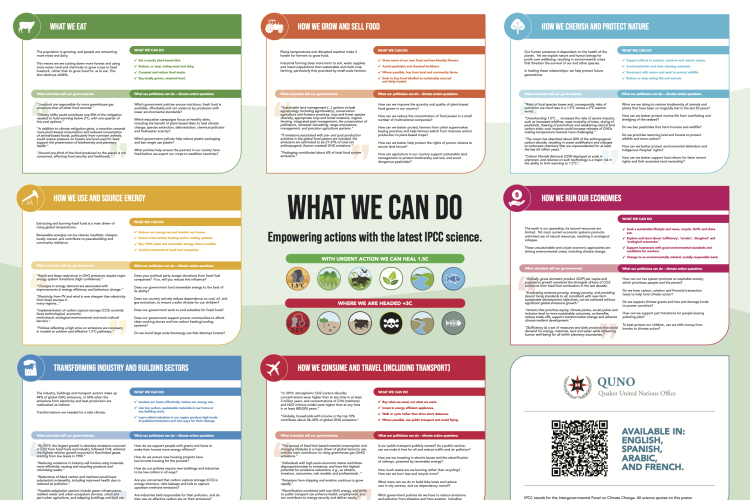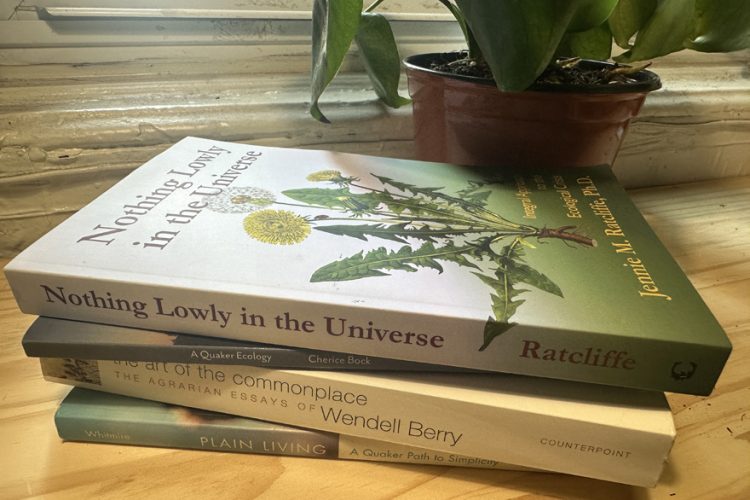Eco-Resources from Friends

We like to begin each new year with an offering of Earth-friendly resources—in print, video, and web content—shared by QEW members and supporters. This year we have a good mix of inspiring and informative sources to recommend. Thanks to all who participated!
THE PERMACULTURE HANDBOOK: GARDEN FARMING FOR TOWN AND COUNTRY
Reviewed by Sophie Quest
South Burlington, Vermont
Spending almost 500 pages with Peter Bane is a great pleasure. Bane is not telling us about the critical state of the Earth today; he takes that for granted and is teaching us how to respond helpfully with our gardens. “The idea that our towns and cities could feed themselves with a little help from the suburbs and the countryside nearby may strike most observers as preposterous, but, as this book attempts to show, the present state of agriculture and energy supply is so unstable that food security for town and country alike depends on our willingness to undertake self-reliance” (p. 5).
Bane recently moved from a large co-op farm situation to a suburb of Bloomington, Indiana. His accompanying story and colorful photos (using his property of 0.7 acres as the first of four case studies) is inspiring. There are no facets of permaculture missing in this book and the case studies demonstrate principles and design successfully applied.
Bane states, “Permaculture is an extension of the empirical practices of science and of indigenous knowledge that preceded it” (p. 21). In this book, beginners can learn all they need to know to begin practicing permaculture, along with ideas for fleshing out every aspect of it as a “design for cultural transformation.” Have you been wondering about how to recycle your own body’s waste? Bane will give you suggestions. Do you want to develop more community in your neighborhood? Bane begins with large kitchens and plenty of beds around the home for drop-in visitors.
Chapter 3 is titled, “Gardening the Planet,” and that’s what he wants to help us do. He informs us about farm animals and wildlife as they help or hinder us. He also gives reasons why we might want to have animals as part of our garden—or not. In the chapter, “Plants and Priorities,” he suggests how each plant, or types of plants, can function as part of your food system. The whole book is filled with photos and diagrams. As a forest gardener, I especially appreciated the chapter, “Trees and Shrubs, Orchards, Woodlands and Forest Gardens,” for its wealth of information. In the final chapter, “Making the Change,” Bane models possible plans, beginning wherever you are and going in the direction you would like to go. He ends the book with this thought: “Garden farming guarantees no one a living, but if enough of us undertake it, we may collectively create a new commonwealth that can vouchsafe dignity and freedom from want to all of us.”
This is a book for all of us, wherever we are on our journey, and it offers deep understanding of permaculture, gardening, and living in the 21st century.
THE GOD SPECIES: SAVING THE PLANET IN THE AGE OF HUMANS

Reviewed by Stan Becker
Homewood Monthly Meeting
The book, The God Species: Saving the Planet in the Age of Humans, by Mark Lynas is an excellent read. The author has reviewed the scientific literature quite comprehensively. The book has chapters built around the nine “planetary boundaries” that were outlined in a paper in the September 24, 2009 issue of Nature, by Rockstrom et al. The boundaries are environmental limits that when surpassed mean danger for planetary ecosystems. They are: biodiversity, climate change, nitrogen pollution, land use, freshwater, toxics, aerosols, ocean acidificaton, and ozone. Note that for the first three, the boundary has already been exceeded.
Of great interest to QEW members is that Lynas challenges at least four mainstream environmentalist positions. Specifically he claims that: (1) Nuclear energy may be an important bridge fuel until we can convert totally to renewables from oil, gas and coal; (2) GMO crops may be the best alternative available to enable us to feed eight billion persons in a few years; (3) Eating local is a nice idea but let’s face it, we have global markets and indeed people in Maine, Vermont, New Hampshire, etc., and Canada would have quite a limited diet in the winter if only locally grown foods were available. Also probably many of us, for example, enjoy orange juice, coffee, tea and/or bananas for breakfast; (4) the “back to the land” movement is nice but counter to what is needed. Again, to feed eight billion persons, industrial agriculture is needed and getting food to people is more efficient if they live in densely populated urban areas. Already 52 percent of the world population live in urban areas and that will only increase. I found myself nearly agreeing with Lynas on these positions as his arguments are quite cogent. Counter-arguments of course exist (for example, see the review by Malvin on Amazon site).
LIFE ON THE BRINK: ENVIRONMENTALISTS CONFRONT OVERPOPULATION
 Reviewed by Ken Lawrence
Reviewed by Ken Lawrence
Yahara Monthly Meeting
If you attended the session on Population and Climate Change at the October QEW Steering Committee meeting and would like to learn more, or if you didn’t attend but are interested in the issue, Life on the Brink would make an excellent resource.
There are 24 chapters by a range of writers, covering population from a wide variety of perspectives. The issue is well defined and explained, covering topics such as human population and biodiversity, environmental refugees, immigration, food, and much more. Solutions are not neglected, with several writers presenting insights on what needs to be done. The style is quite readable, presenting lots of facts but not overwhelming the reader, and each chapter is well footnoted.
From Chapter one, by the editors: “We find joy in the abundant beauty and variety that Earth provides. We find safety in a relatively predictable climate and reliable food sources. We find inspiration in the grandeur of this extraordinary planet. The scale of humanity’s presence – let alone our continued growth – imperils these sources of our well-being and the very existence of innumerable other life-forms. We thus are called, even at this late hour, to find the clarity and courage to shift into a new relationship with Earth, before we diminish irrevocably the greater-than-human world, our own lives, and the lives of future generations.
JOURNEY OF THE UNIVERSE

Reviewed by Louis Cox
The 2011 video, Journey of the Universe, is an excellent guidebook and inspiration for those of us who are working to avert ecological breakdown on our fragile planet. As environmental writer Gus Speth put it, “This story of the universe has the potential to change our civilization.”
Written by cosmologists Brian Swimme and Mary Evelyn Tucker, this 55-minute DVD distills much of the content of Swimme’s much longer video series The Canticle to the Cosmos, which popularized leading-edge thinking about recent revolutionary discoveries in physics and the life sciences. With better graphics and cinematography and fewer talking heads, the new video has increased power to engage and motivate people from many backgrounds.
You might understandably ask, “How does an account about our creatively unfolding universe—while perhaps valuable as an academic study—help us deal with the urgent crises of environmental pollution, resource depletion, climate disruption, and overpopulation? What does the new universe story have to do with the situation we find ourselves facing now?” The short answer is “Everything.”
Swimme’s narration of Journey of the Universe is all the more engaging because it takes place on the Greek island of Samos, where many of the ancient world’s great advances in science and mathematics were made. New thought processes were awakened that led to ever-deeper understanding of the principles behind the natural world. At the same time, foundations were laid for countless techniques for exploiting and destructively altering the natural world for human purposes.
This video explains why we can’t resolve today’s ecological crises without understanding our species’ long journey of evolving symbolic consciousness, which cannot be isolated from the even longer journey by which life itself emerged on this planet as a natural outgrowth of a self-organizing universe. Only by charting the waypoints of our journey can we hope to realize that we are racing in the dark toward an iceberg. Only by understanding the element in which we are traveling can we hope to devise an emergency course correction.
Understanding the new universe story makes the vital difference between “science” that is interested mainly in using technology to help us become masters of nature, and true science that seeks, in the tradition of the ancient Greeks, to understand how the natural world works and how to live in partnership with it.
The new story makes the essential difference between the mind-set that would hastily inject sulfur dioxide into the upper atmosphere in a desperate attempt to induce artificial global cooling and the emerging wisdom that we will survive and thrive as a species only if we allow the rest of the Earth community to flourish.
The video and its companion book, Journey of the Universe by Brian Thomas Swimme and Mary Evelyn Tucker (2011), are available through http://journeoftheuniverse.org.
SYNCHRONICITY –THE INNER PATH OF LEADERSHIP
 Reviewed by Mary Jo Klingel
Reviewed by Mary Jo Klingel
Have you ever read a book that you had been waiting for, but you didn’t know it? Synchronicity by Joseph Jaworski was such a book for me.
Synchronicity is both the story of Joseph Jaworski’s personal journey and his seeking to understand new ways to envision leadership. He weaves in his increasing understanding and work with the concept of synchronicity.
Jaworski began his career as an attorney, striving to “always work harder than the other guy.” By the mid-1970s he was very successful, living “the picture perfect life” (p. 26). Then a personal crisis caused his world to crash and set him on a journey of self-discovery.
He began to experience what he called the “collective state of flow.” Doors opened, people who had exactly what he needed walked into his life. He envisioned “a new type of leadership that enriches and empowers” (p.60). He came to see “the extraordinary power of a group committed to a common vision” which formed the basis for his developing the Leadership Forum. His goal was to “provide the gateway to those fundamental shifts of mind and being, so necessary to servant leadership” (p. 107).
To his credit, he includes a chapter on the “internal traps” that pulled him out of the flow, such as a growing pattern of over-responsibility. He writes about “the three fundamental shifts of mind necessary for the creative leadership I believe is so crucial for our future” (p.183), including a fundamental shift in our understanding of relationships.
My only regret is that he seemed to be unaware of Friends. I wrote in the margin on page 61, “He would have saved himself so much work if he had become a Friend.” When I read what he wrote on page 116, “When people sit in dialogue together they are exercising leadership as a whole. This is nothing less than the unfolding of the generative process. It’s the way that thought participates in creating, but it can only be done collectively,” I thought, he is talking about a gathered meeting.
This is a book that grapples with the mystery of the implicate order becoming manifest. I found myself asking what we as Quaker environmentalists want to manifest and what we will now commit to the work of manifesting it.
I encourage you to read Synchronicity. If you do, please let me know. Let’s talk. Doors do open.
ADDITIONAL RECOMMENDATIONS FROM FRIENDS
Donn Kesselheim says, “I highly recommend Joan Borysenko’s Pocketful of Miracles.” http://www.amazon.com/Pocketful-Miracles-Meditations-Affirmations-Nurture/dp/0446395366/ref=sr_1_1?s=books&ie=UTF8&qid=1388249924&sr=1-1&keywords=pocketful+of+miracles
David Millar says, “The latest Canadian Friend has good stuff. I heartily recommend p.15 and p.17: http://quaker.ca/wp-content/uploads/2013/11/December-2013-web.pdf“
Jeff Kisling offers, “Here is a link to a photo documentary from the 14.5 mile Earth Walk November 3, 2013. Iowa Yearly Meeting (Conservative)’s Scattergood Friends School is a 60 student co-ed high school on a farm outside West Branch, Iowa: http://tinyurl.com/n3elljv
We held a Climate Conference on Saturday, November 2. Then Sunday, several students, faculty and others walked from the School into the local university (Iowa State University), carrying signs about our environment and picking up trash from along the road. (PS: The entire student body and the staff of the school also did this same walk in 1969 during one of the Vietnam War Moratorium days.)”
Mary Coehlo suggests the following: “This 19 minute video is about the effect on astronauts upon seeing Earth from space. It is entitled, Some Strange Things Are Happening to Astronauts Returning to Earth. We know intellectually that we are dependent on the ongoing viability of the planet but seeing a new Earth from space we are reminded of the beauty of Earth, the most remarkable nature of our living planet and the urgency of our work: http://www.upworthy.com/some-strange-things-are-happening-to-astronauts-returning-to-earth?g=5
Sarah Merrill has two books coming out in 2014 that she’d like to recommend. International Casebook in Construction Ethics: 101 Case Studies from Contractors, Architects, Owners, and End-Users (NY: AcademicPub) is the first book to be published on Ethics in the construction engineering and management fields. The book includes 101 case studies, at least half of which are about environmental issues; for example, the construction of dams and other disturbances to rivers and lakes, oceans, forests, and habitats of rare and endangered species. Because at least 30 percent of landfills consist of construction waste and green building now seems a moral duty for all owners and builders, this book documents and encourages more consideration in the public discourse and ethics of professional practice in greener building. Some creative projects are highlighted with photographs and interviews with contractors who had to train their subcontractors in green building materials and methods, in the face of strong resistance and habits.
The second book, Muddy Boots: Social, Political, and Environmental Philosophies of Sustainability in Construction (NY: AcademicPub) [available in ebook format after 01/06/14]) has been used in social and political philosophy, ethics, and introduction to philosophy classes. It is a collection of readings about social contract theory and environmental philosophy, foundations for a new philosophy of sustainability which must become part of a new way of thinking.


